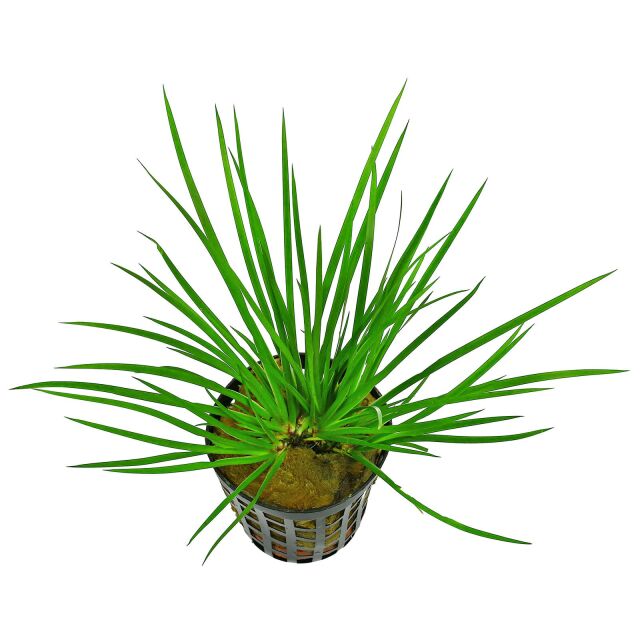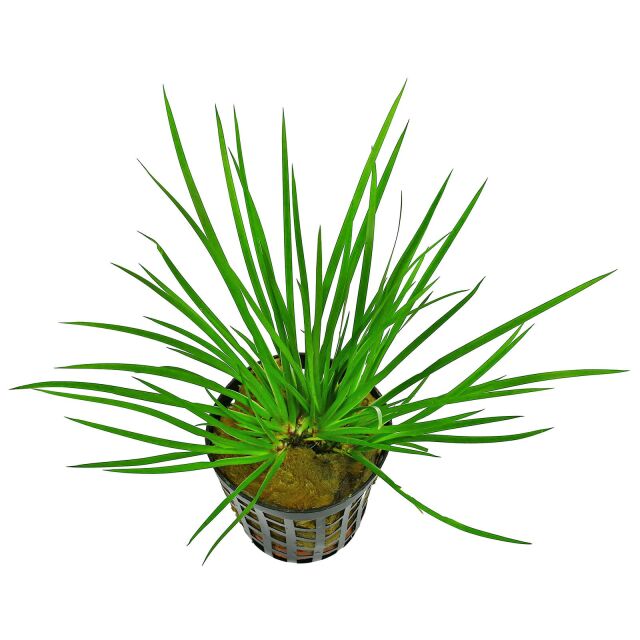Dwarf Sweet Flag



Acorus gramineus 'Pusillus'
Dwarf Sweet Flag
- Grass-like look
- About 10 cm high
- Especially suitable for paludariums and terrariums
Item question
We’re here for you!
Please enter your question and e-mail and we’ll contact you as soon as possible. It usually takes us up to 24 hours during business days to respond.
Thank you for your question!
Thank you, we’ll get in touch!
Close window
You already sent us a question.
Please wait a few minutes
Description
The Grass-leaf sweet flag or Japanese rush, Acorus gramineus, is widespread in East and Southeast Asia. It occurs i.a. at swiftly flowing, rocky forest streams and waterfalls, between pebbles, also clinging on rock by its roots. In these habitats, it is adapted to floods with strong current.
Acorus gramineus is an old ornamental plant. There are several cultivars such as the white-striped 'Variegatus'. We offer the dwarf cultivar 'Pusillus' that mostly gets only about 10, at most 15 cm high. It is also named as a variety, Acorus gramineus var. pusillus. Otherwise, wild types of Acorus gramineus may get 30-50 cm tall.
The Japanese rush is often regarded as of limited value for aquariums. However, we found out that at least the Dwarf sweet flag, Acorus gramineus 'Pusillus', can be grown permanently submerged. Provided that the rhizome is not buried into the substrate, otherwise the plant may die off. It should be fastened to objects such as stone or wood where it attaches itself by its roots, or fixed to the ground, comparable to Anubias species or Java fern. The growth is very slow, and with time side branches on the rhizome may appear that can be cut off for propagation. We recommend complete macro- and micronutrient supply via the water column, CO2 addition and good current. Medium lighting is sufficient. Acorus gramineus 'Pusillus' prefers rather cooler temperatures; the optimum lies at 18-23 °C.
As a terrestrial plant, the Dwarf sweet flag is very easy to grow. The substrate, e.g. customary potting soil, needs to be moderately moist but not wet. The plant can overwinter cold, but frost-free.
This grass-like, decorative plant fits particularly well to layouts that are inspired by rocky stream habitats. It is also well suited for cold water aquariums. However, as mentioned above, its successful submerged culture presupposes that its rhizome is not buried into the substrate. Its use as an "epiphyte" for the hardscape is still hardly known but worth trying. The Dwarf Sweet Flag can also be used as a robust terrestrial plant in many ways, e.g. for paludariums, ripariums, terrariums and Wabi-Kusa.
'Pusillus' is a dwarf form of the Grass-leaf sweet flag or Japanese rush, Acorus gramineus. This cultivated form has also been ranked as a variety, Acorus gramineus var. pusillus. It is in the aquarium trade for a long time, but it is mostly regarded as of limited value or not at all suitable as aquarium plant. However it can very well be grown permanently submerged, at least when it is attached to hard materials (see Schulz 2018).
Acorus gramineus 'Pusillus' is often not taller than 10 cm, however it may reach a hight of about 15 cm.
- To be continued -
| Common names | Dwarf Sweet Flag |
| Synonyms | Acorus gramineus var. pusillus |
| Trader names | Acorus pusillus, Acorus pussilus |
| Complete botanical name | Ácorus gramíneus Solander |
| Family | Acoraceae |
| Genus | Acorus |
| Difficulty | easy |
| Usage | Epiphyte (growing on hardscape), Midground, Nano tanks |
| Growth | very slow |
| Temperature tolerance | 4 - 28°C |
| Propagation | Rhizomteilung, Splitting, cutting off daughter plants |
| Source | Flowgrow |
| Common names |
| Dwarf Sweet Flag |
| Synonyms |
| Acorus gramineus var. pusillus |
| Trader names |
| Acorus pusillus, Acorus pussilus |
| Complete botanical name |
| Ácorus gramíneus Solander |
| Family |
| Acoraceae |
| Genus |
| Acorus |
| Difficulty |
| easy |
| Usage |
| Epiphyte (growing on hardscape), Midground, Nano tanks |
| Growth |
| very slow |
| Temperature tolerance |
| 4 - 28°C |
| Propagation |
| Rhizomteilung, Splitting, cutting off daughter plants |
| Source |
| Flowgrow |
General information
Please choose a variant to see more information.
| Item no. |
|
| EAN | |
| Weight | |
| Shipping weight |
Customers ask customers
You have questions about this product? Ask other customer or our support team about this product!
Customer reviews
2 Reviews
| 5 Stars(2) |
|
| 4 Stars(0) |
|
| 3 Stars(0) |
|
| 2 Stars(0) |
|
| 1 Star(0) |
|

This plant looks really nice in Wabi-kusa and paludariums. It is very elegant and I like a lot his smell.

It came in with a spider O_o.. but I love the plant. It looks really healthy and lush. It really looks like the picture